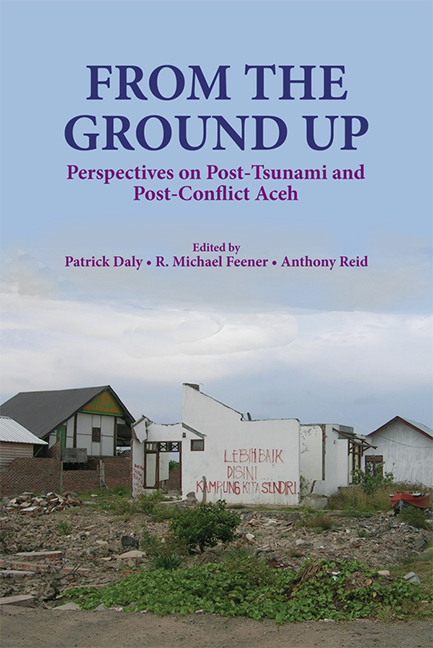Book contents
- Frontmatter
- Contents
- Preface
- List of Figures and Tables
- The Contributors
- Glossary and Abbreviations
- Introduction: Unpacking the Challenges of Post-2004 Aceh
- 1 The Sunda Megathrust: Past, Present and Future
- Part I Reconstruction Efforts
- 2 Disaster Recovery: An International Humanitarian Challenge?
- 3 Linking Relief, Rehabilitation and Development (LRRD) to Social Protection: Lessons from the Early Tsunami Response in Aceh
- 4 Cultural Heritage and Community Recovery in Post-Tsunami Aceh
- 5 Managing Post-Disaster Reconstruction Finance: International Experience in Public Finance Management
- 6 Between Custom and Law: Protecting the Property Rights of Women after the Tsunami in Aceh
- 7 Factors Determining the Movements of Internally Displaced Persons (IDPs) in Aceh
- 8 Aceh's Forests as an Asset for Reconstruction?
- Part II Conflict Resolution
- Index
3 - Linking Relief, Rehabilitation and Development (LRRD) to Social Protection: Lessons from the Early Tsunami Response in Aceh
from Part I - Reconstruction Efforts
Published online by Cambridge University Press: 21 October 2015
- Frontmatter
- Contents
- Preface
- List of Figures and Tables
- The Contributors
- Glossary and Abbreviations
- Introduction: Unpacking the Challenges of Post-2004 Aceh
- 1 The Sunda Megathrust: Past, Present and Future
- Part I Reconstruction Efforts
- 2 Disaster Recovery: An International Humanitarian Challenge?
- 3 Linking Relief, Rehabilitation and Development (LRRD) to Social Protection: Lessons from the Early Tsunami Response in Aceh
- 4 Cultural Heritage and Community Recovery in Post-Tsunami Aceh
- 5 Managing Post-Disaster Reconstruction Finance: International Experience in Public Finance Management
- 6 Between Custom and Law: Protecting the Property Rights of Women after the Tsunami in Aceh
- 7 Factors Determining the Movements of Internally Displaced Persons (IDPs) in Aceh
- 8 Aceh's Forests as an Asset for Reconstruction?
- Part II Conflict Resolution
- Index
Summary
A GOOD START, BUT WHAT ABOUT DEVELOPMENT?
The tsunami had an immense impact on development processes, conflicts, patterns of risk and poverty in affected areas, as did the subsequent relief and reconstruction efforts. This chapter looks at how affected populations in Aceh have coped with the disaster from a social protection perspective. It considers how they have continued to manage their own welfare both with and without aid. Specifically, it focuses upon issues of poverty alleviation, equity, and the linking of relief, reconstruction and development (LRRD) in the aftermath of the 2004 tsunami. As part of this exploration, questions are asked about whether the reconstruction and development efforts have buttressed or compromised the social protection mechanisms that people already had in place at the family and community levels prior to the disaster.
Conceptually, “social protection” comes from the European welfare state design that recognizes three pillars of welfare: private, government and market. Resources move among these three pillars in accordance with the welfare needs of individuals and families. Such a design recognizes and responds to changing levels of societal development and consequences that create risks. In the case of Aceh and the rest of Indonesia, social protection needs to factor in the many unpredictable man-made and natural disasters faced, as part of efforts to better link these pillars.
There is a growing realization that, from the perspective of the economically disadvantaged, shocks are not abnormal. Disasters and hazards, large and small, are an ever-present threat that profoundly affects livelihood strategies. In recognition of this, social protection has become a central issue in the development debate in many countries, even though the term means different things to different people. Social protection may encompass social assistance schemes, social security, social funds, cash transfers and other structures that provide a safety net for those at risk of becoming destitute, or a safety net to provide subsidized support for those struggling to rebuild their lives in the aftermath of trauma.
- Type
- Chapter
- Information
- From the Ground UpPerspectives on Post-Tsunami and Post-Conflict Aceh, pp. 40 - 56Publisher: ISEAS–Yusof Ishak InstitutePrint publication year: 2012



